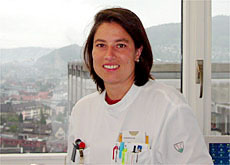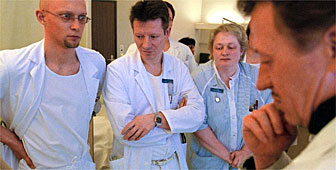A day in the life of a junior doctor

Switzerland's health service is coming under increasing strain owing to rising costs and lengthening waiting lists.
swissinfo joined a junior doctor at the start of her hospital shift to find out how government policy is affecting young medics.
The country certainly has no shortage of doctors, with 25,000 for a population of seven million, or one doctor per 280 inhabitants. Of these, 11,000 work in hospitals.
But junior doctors say they are worried about the future because of numerous cost-cutting measures by the government, such as a recent moratorium on new general practitioners’ (GPs) surgeries.
Bidisha Chatterjee, who is of Indian origin but raised in Switzerland, is a junior doctor at the University Hospital in the Swiss capital, Bern. The 32- year-old works in the internal medicine department, which treats diseases such as cancer, diabetes and heart conditions.
She starts her day at around 7.45am with two meetings: one to go over the night’s admissions; the other to look at X-rays.
Four more years
Over a cup of coffee in the staff cafeteria, she explains that having served as a junior doctor for three years, she still has a long way to go before she fulfils her dream of becoming a cardiologist.
“I will be a junior doctor in the cardiology department for another four years,” Chatterjee told swissinfo.
“But that all depends on my passing [exams] and getting experience in every sub-speciality in the cardiology department,” she added.
Chatterjee says the best part about her job is the great variety of tasks she is assigned to do during the day and, of course, dealing with the patients.
Junior doctors used to work extremely long hours, but the hospital has now restricted their timetables to 52 hours per week – though this does not always work out in practice.
A 50-hour week for junior doctors was approved by parliament in 2002 and is due to come into force nationwide in 2005.
Daily rounds
After the early morning meetings and her break, Chatterjee heads to the ward to make her daily rounds.
Our first visit is to an elderly female patient, who has been in hospital for a month because of ulcers on her legs.
Chatterjee asks if Mrs von Allmen is in pain and whether she has been sleeping.
“I’m in a little bit of pain but I managed to get some sleep for half of the night,” says the patient. The junior doctor reassures her and then discusses further treatment.
No jobs
As she continues her rounds, Chatterjee explains that she is concerned about several government measures which affect doctors.
Many of her colleagues in internal medicine aim to become GPs, but in July 2002 the Swiss government imposed a controversial three-year moratorium on the opening of new GP surgeries in a bid to cut costs.
“I think the prospects are getting really difficult. I’m not allowed to become a GP [for the time being], whether I want to become one or not,” Chatterjee told swissinfo.
“So now there are more junior doctors staying in the hospitals… and it’s becoming quite difficult to get a job in a hospital.”
Blame
Chatterjee says she also finds it unfair that doctors are being increasingly blamed for the country’s spiralling health costs, which are among the most expensive in the world.
According to 1998 figures from the Organisation of Economic Cooperation and Development, health accounts for 10.4 per cent of Swiss Gross Domestic Product (GDP).
This puts Switzerland in second place behind the United States, which spends 12.9 per cent of GDP on health.
But it is not just the costs that are rising: health insurance premiums in Switzerland have also been increasing over the past few years.
Premiums have risen by an average 4.3 per cent this year – the third year in a row that they have gone up.
Medical care and health insurance premiums featured among voters’ biggest concerns in last October’s parliamentary elections.
Black sheep
“Doctors are increasingly becoming the black sheep of society,” explained Chatterjee. “I have the impression that some doctors are being held responsible for new [health] policies adopted by politicians and health insurance companies,” she added.
She believes that two of the main reasons for the rise in costs are that drugs and treatments have become more expensive, and that greater public awareness of health issues is leading more people to asks for tests.
Chatterjee’s rounds last from one to two hours. Afterwards she does some administrative tasks and discusses her patients’ conditions with the senior doctor, before carrying out her last tour of the ward with the nurses at 4pm.
The junior doctor says that on a good day she can even leave at 5pm. But, as with all hospital staff, it’s never possible to plan how many hours she will do per shift – it all depends on the needs of her patients.
swissinfo, Isobel Johnson
Switzerland has 25,000 doctors serving a population of seven million.
11,000 doctors work in hospitals.
A 50-hour week for junior doctors is due to come into force in 2005.
Bern University Hospital was completed in 1885, but doctors have been trained in Bern since the 16th century
Dr Bidisha Chatterjee has been a junior doctor for three years and still has at least four years of training before she can become a cardiologist.
She is restricted to 52 hours per week, but this does not always work out in practice.
She works in internal medicine, which is concerned with the prevention and treatment of adult diseases.

In compliance with the JTI standards
More: SWI swissinfo.ch certified by the Journalism Trust Initiative


You can find an overview of ongoing debates with our journalists here. Please join us!
If you want to start a conversation about a topic raised in this article or want to report factual errors, email us at english@swissinfo.ch.